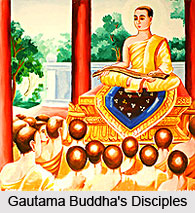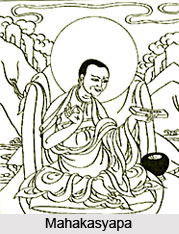 Ananda was most revered among Gautama Buddha`s disciples. He was the cousin of Buddha and the younger brother of infamous Devadatta. Ananda had excellent capability of memorizing Buddha`s teachings. So after Buddha`s death when his disciples gathered together, Ananda was invited to recite Buddha`s teachings.
Ananda was most revered among Gautama Buddha`s disciples. He was the cousin of Buddha and the younger brother of infamous Devadatta. Ananda had excellent capability of memorizing Buddha`s teachings. So after Buddha`s death when his disciples gathered together, Ananda was invited to recite Buddha`s teachings.
Ananda was born on the same day when Prince Siddhartha achieved enlightenment and became Buddha. Once Buddha was seeking a personal attendant for him and addressed to his followers that he was getting old and he needed not only a personal attendant to take care of him, but also a person who has very good memory to remember all his words and pass on his messages.
At first Ajnata-Kaundinya, one of the first five disciples of Buddha stood up and approached to Buddha to serve him. But Buddha rejected his prayer, as he was old too.
Maudgalyayana then meditated to search someone from the monks who would be suitable to serve Buddha and he found Ananda. It seemed that Buddha had already chosen Ananda. So Maudgalyayana stood up and addressed everybody in a loud voice that venerable Ananda was the best choice to serve Lord Buddha since he was young, polite and smart. He treated everyone equally and kindly and could memorize all the words of Buddha. Maudgalyayana then asked about the opinion of other monks. All the monks agreed and prostrated themselves before Buddha. Then the monks got up and went to Ananda`s room. When they saw Ananda, they folded their hands and made a half-bow, the way of greeting amongst the Buddhist monks and then asked Ananda if he would be interested to be the personal attendant of Buddha.
Ananda replied humbly that he would be extremely honored to be Buddha`s attendant but he did not think that he was qualified for that. Maudgayayana the told Anand very seriously that Buddha was like Udumbara flower that only flowers once in every three thousand years. It was extremely rare to get a chance to meet Buddha. Finally he addressed Anand and requested him to grasp the scope of being Buddha`s attendant.
Ananda then said that if Lord Buddha agreed to three conditions, he would take on the responsibility. The first was that he would never wear Buddha`s robe whether new or used; second if any devotee wanted to invite Buddha at a feast, he would not go along with him and finally, when it was not the time to visit Buddha, he would not visit him.
 Maudgalyayana bade farewell to Ananda and went back to Buddha`s residence along with the other monks. Maudyagalyayana reported their conversation to Buddha. Buddha highly praised Ananda and said Ananda was a person of virtue and high character. He made the three conditions first because he wanted to prevent other people thinking that he wanted be the chief attendant of Lord Buddha because of his desire for good food or good dresses. Buddha thereby totally agreed with his requests.
Maudgalyayana bade farewell to Ananda and went back to Buddha`s residence along with the other monks. Maudyagalyayana reported their conversation to Buddha. Buddha highly praised Ananda and said Ananda was a person of virtue and high character. He made the three conditions first because he wanted to prevent other people thinking that he wanted be the chief attendant of Lord Buddha because of his desire for good food or good dresses. Buddha thereby totally agreed with his requests.
Ananda was only nineteen years old when he was chosen to be Buddha`s attendant. He followed Buddha for rest of the twenty-seven years of his life. Ananda was highly respected by everyone in the Sangha because of his polite and humble behavior. He never boasted on his merits nor he talked about shortcomings of other people. Ananda always did his best to help other people. When he discussed Buddha`s teachings with other religious groups, he never criticized the doctrines of their belief. Ananda used to state only the good points of Buddha`s teachings.
When Buddha passed away, Ananda left for the city of Sravasti, three days after his death. There was a competition to be held at that city about the teachings of Buddha. Kasyapa, another disciple of Lord Buddha was the chairperson of that group. He rejected Ananda as Ananda did not attain the enlightenment.
Ananda was very upset at this incident. He returned to his room and started to work hard for his spiritual upliftment. After seven days he finally attained enlightenment or arahanthood. After being enlightened Ananda went back to the meeting. When he walked towards the stage the audience were stirred. Ananda, who was Buddha`s cousin looked like Buddha and the radiance achieved from the enlightenment made his resemblance closer to Buddha. So some people thought Buddha had returned from death while some thought Ananda has become Buddha or another Buddha had arrived on earth.
Ananda understood that there was a confusion regarding him and he wanted to put an end to it. He started the recitation with the phrase ` thus I have heard` to indicate that he was the same Ananda as before, who repeated Buddha`s teachings. He did not give any lecture but repeated Buddha`s teachings. Thus the audience was out of the confusion.
When Ananda reached hundred and twenty years of age, he corrected one monk as he was reciting wrong. The young monk told his mentor about this and his mentor said Ananda was wrong, as he has become old and senile. When Ananda knew this from the young monk he became upset. He realized that people were not following Buddha`s teachings properly. He felt lonely as all of the Buddha`s chief disciple left the world. Ananda then walked to Ganges flowing between Magadha and Vaishali, which were then preparing for the war. Ananda thought that if he died in either of this state, one state would not share his remains with the other state. Therefore he resolved to pass away above the river.
When Ananda`s boat approached to the middle of the river, the kings from both the states arrived at either side of the river. They shouted at Ananda and asked him not to give away his life. When the boat arrived at the middle of the river, Ananda jumped up to the sky and burned himself with a fire coming inside his body. Because of this incident the two fighting countries stopped war between each other. His remains were divided and each of the two countries kept half of his remains. Thus, thousands of lives were saved.



















